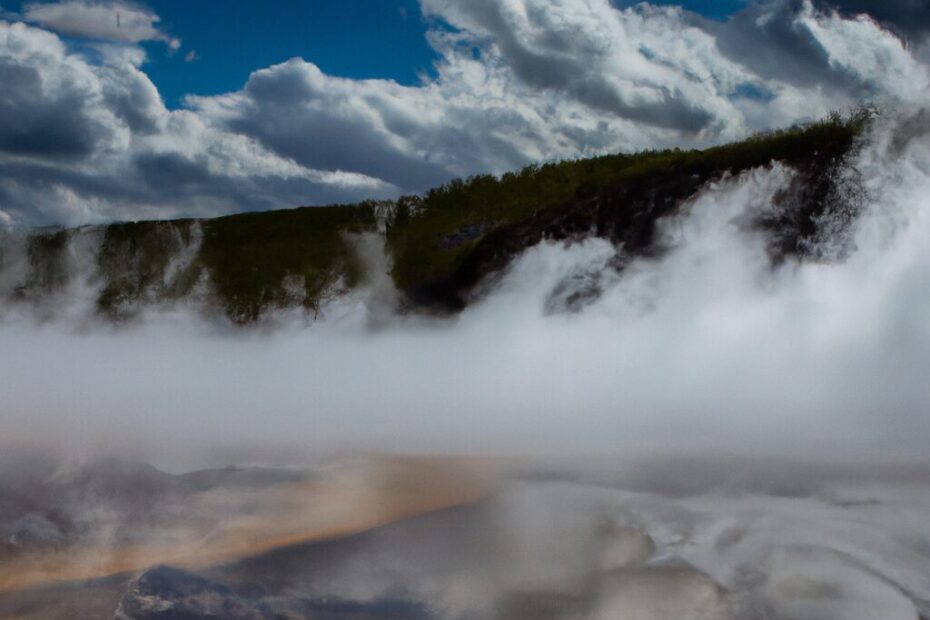Yellowstone National Park is not only home to stunning landscapes and diverse wildlife but also boasts a unique geological feature – geysers. In this article, we will explore the significance of geysers in Yellowstone, focusing on iconic attractions such as Old Faithful and Steamboat Geyser.
Delving into the history of geysers in the park, we will uncover the ancient legends, scientific discoveries, and modern research that have shaped our understanding of these natural wonders. Join us as we uncover Yellowstone’s contributions to geyser studies and their impact on global geothermal energy, planetary geology, and conservation efforts.
What Are Geysers?
Geysers are unique geological phenomena characterized by intermittent hot springs that eject steam and water, often accompanied by volcanic activity, such as in the geothermal landscape of Yellowstone National Park.
These mesmerizing natural features are created when underground water is heated by molten rock beneath the Earth’s surface, causing it to rise back to the surface as a mixture of steam and water. The pressure builds up until the water eventually erupts in a powerful burst, creating the iconic spouting effect that geysers are known for. This connection to volcanic activity stems from the presence of magma chambers and other geological processes that contribute to the heat and pressure required for geyser formation.
Yellowstone National Park, located atop a hotspot of geothermal features, is home to some of the most famous geysers in the world, including the renowned Old Faithful, which showcases the dynamic interplay between Earth’s internal forces and surface manifestations.
Yellowstone’s Unique Geyser Features
Yellowstone National Park boasts a collection of unique geyser features that showcase a diverse array of thermal phenomena, making it a worldwide attraction for geology enthusiasts and scientific exploration.
Visitors are drawn to the renowned Old Faithful, famous for its predictability in eruption times, and the mesmerizing Grand Prismatic Spring, known for its vibrant colors created by microbial communities. These geothermal marvels serve as living laboratories for researchers studying geothermal exploration and thermal activity. The park’s active volcanic history provides a rich environment for understanding Earth’s geologic processes, contributing valuable insights to global geothermal studies. Yellowstone’s commitment to preserving these natural wonders also underscores its role in promoting environmental conservation and geothermal education.
Old Faithful
Old Faithful, one of Yellowstone’s most iconic geysers, is renowned for its predictable and impressive eruptions, drawing visitors and researchers to witness its natural spectacle and contribute to ongoing monitoring efforts.
This famous geyser has been captivating audiences since it was named in the late 19th century for its faithfulness to erupt almost every hour. Its behavior has been integral to the study of geysers, aiding scientists in understanding the underlying geological processes that drive such spectacular displays. Monitoring techniques, including seismographs and thermal imaging, have provided valuable data on the timing and intensity of its eruptions.
Old Faithful’s consistent performance serves as a benchmark for geyser conservation efforts within Yellowstone National Park, highlighting the delicate balance between preservation and environmental management.
Steamboat Geyser
Steamboat Geyser, the world’s tallest active geyser located in Yellowstone, captivates researchers and visitors alike with its sporadic and powerful eruptions, offering unique insights into geyser behavior and geological processes.
Its eruptions, reaching heights of over 300 feet, stand out for their unpredictable nature, erupting at irregular intervals that can range from days to years, contrasting with the more regular patterns of other geysers. These characteristics make Steamboat Geyser a fascinating subject for geologists studying geothermal features. The geyser’s distinctive behavior provides valuable data on underground hydrothermal activity, aiding scientists in understanding the complex processes that drive these impressive natural phenomena.
Castle Geyser
Castle Geyser, a prominent feature of Yellowstone’s geyser basins, showcases unique geological formations and distinct characteristics that exemplify the diverse range of thermal activity within the park.
Situated in the Upper Geyser Basin, Castle Geyser stands as a testament to the deep-rooted geothermal phenomena that shape the park’s landscape. Its towering cone and periodic eruptions draw in visitors seeking to witness the raw power of nature unfold before their eyes. As one of the oldest geysers in Yellowstone, its history unravels the complex interplay of underground water sources, heat, and pressure that lead to the spectacular displays observed today. Studying the behavior of Castle Geyser offers insights into the mechanisms governing geyser eruptions and helps scientists decipher the secrets of these mystical geothermal wonders.
History of Geysers in Yellowstone
The history of geysers in Yellowstone dates back centuries, intertwined with Native American legends, early explorers’ accounts, and the gradual development of scientific exploration and understanding of these remarkable thermal features.
Cultural beliefs among Native American tribes in the region often regarded geysers as sacred entities, believed to possess extraordinary powers and connections to the spiritual realm.
Early European explorers were captivated by the natural spectacle of erupting geysers, with accounts of their majestic displays spreading across continents.
It wasn’t until the 19th century that systematic studies of geysers and other hydrothermal phenomena started taking shape, leading to a deeper appreciation of the underlying geological processes that drive these natural wonders.
Native American Legends and Beliefs
Native American legends and beliefs regarding Yellowstone’s geysers provide a rich tapestry of cultural interpretations and spiritual connections to the awe-inspiring natural wonders found within the park.
These traditions often depict geysers as powerful manifestations of the Earth’s spirit, reflecting the delicate balance of the ecosystem and biodiversity. Geysers are often seen as portals to the spiritual realm, where ancestral wisdom is believed to reside. In many stories, geysers are revered for their healing properties and transformative energies, symbolizing renewal and purification. The eruptive nature of geysers is seen as a reminder of the cyclical nature of life and the interconnectedness of all living beings within the natural world.
Early Explorers and Scientists
Early explorers and scientists in Yellowstone played a pivotal role in documenting geyser sightings, conducting research expeditions, and unraveling the mysteries of the park’s geothermal wonders through systematic observation and analysis.
Their studies involved meticulous geothermal monitoring to track changes in geyser behavior over time, providing valuable insights into the underlying geological processes. Through their dedication, these early pioneers laid the foundation for modern scientific exploration of geothermal landscapes and the development of environmental protection measures to ensure the preservation of Yellowstone’s unique geothermal features for future generations.
Development of Geyser Studies
The development of geyser studies in Yellowstone marked a significant milestone in scientific exploration, paving the way for in-depth research on hydrothermal phenomena, geological processes, and ecosystem dynamics within the park.
Researchers have utilized various scientific methodologies, such as remote sensing techniques, geochemical analysis, and geophysical monitoring, to delve deeper into the intricate workings of geysers.
Through interdisciplinary collaborations between geologists, biologists, and climatologists, a more holistic understanding of geothermal activity and its impact on the surrounding environment has been achieved.
This collaborative effort has not only enhanced our knowledge of geysers but also contributed to the preservation and conservation of these natural wonders for future generations to cherish and study.
Yellowstone’s Contribution to Geyser Research
Yellowstone’s pivotal role in geyser research extends beyond its borders, offering a wealth of data on geyser behavior, geothermal features, and hydrothermal processes that contribute to a deeper understanding of these natural wonders worldwide.
- Research initiatives in Yellowstone focus on leveraging advanced data collection methods to monitor geothermal resources and geological formations. Scientists use cutting-edge technologies like seismometers to track subsurface movements and thermal cameras to analyze surface temperatures. This detailed monitoring helps unravel the intricate relationship between geological formations and geothermal activities in the park.
- By studying Yellowstone’s unique geothermal phenomena, researchers gain insights that are crucial for advancing knowledge in global geothermal research and addressing sustainability challenges related to harnessing geothermal energy.
Monitoring and Data Collection
The monitoring and data collection efforts in Yellowstone play a crucial role in tracking geyser behavior, seismic activity, and hydrothermal changes, providing valuable insights into the dynamic nature of geothermal systems.
These monitoring techniques involve the utilization of various tools such as seismometers to record seismic waves generated by geothermal activity. Infrared cameras are deployed to capture temperature changes, and GPS technology tracks ground movement caused by underground geological processes. Continuous observation allows researchers to identify patterns in geyser eruptions and fluctuations in heat flow, aiding in the study of geothermal energy potential.
By integrating these data collection methods, scientists can gain a better understanding of the complex interactions within Yellowstone’s geysers and their broader geothermal systems.
Geothermal Features and Processes
Yellowstone’s geothermal features and processes offer a living laboratory for studying the intricate interactions between geology, hydrology, and ecology, shaping the diverse ecosystem and biodiversity within the park.
The remarkable geothermal landscape of Yellowstone National Park is a mesmerizing result of the Earth’s internal heat interacting with various geological formations, underground water systems, and the surrounding environment. This unique interplay gives rise to phenomena such as geysers, hot springs, and fumaroles, showcasing the ongoing volcanic activity beneath the surface. Geothermal exploration in the park provides scientists with invaluable insights into how these forces shape the land and support the diverse range of plant and animal life that thrive in this dynamic thermal environment.
Predicting Geyser Eruptions
Predicting geyser eruptions in Yellowstone involves complex analyses of geological data, seismic patterns, and hydrothermal indicators to enhance our understanding of the underlying mechanisms driving these thermal events.
By integrating advanced monitoring technologies such as GPS sensors, thermal cameras, and drones, scientists can capture real-time data on temperature changes, water levels, and ground deformation near geysers. This wealth of information is then processed using sophisticated predictive models that consider factors like historical eruption patterns, pressure buildup, and mineral precipitation. These models not only help in eruption forecasting but also contribute to ongoing scientific advancements in geyser behavior analysis, aiding in the conservation and sustainable management of these natural geothermal features.
Impact of Yellowstone’s Geyser Studies on Global Understanding
Yellowstone’s geyser studies have significantly influenced global understanding of geothermal energy potential, planetary geology insights, and the importance of conservation efforts in preserving natural wonders for future generations.
Exploring Yellowstone’s geothermal studies has not only advanced our knowledge of sustainable energy sources but also shed light on the geological processes at work deep within our planet. By studying the geysers at Yellowstone, scientists have gained valuable insights that can be applied to geothermal energy production worldwide. These studies have provided crucial information for understanding the complexities of planetary geology, offering new perspectives on similar geological features found on other celestial bodies. This research also underscores the critical role of environmental protection in safeguarding unique ecosystems like Yellowstone National Park.
Advancements in Geothermal Energy
The advancements in geothermal energy research driven by Yellowstone’s geyser studies have revolutionized sustainable energy practices, offering insights into harnessing Earth’s natural heat reservoirs for power generation and environmental conservation.
Through ongoing geothermal monitoring efforts in Yellowstone, researchers have been able to uncover efficient energy extraction methods from geothermal systems. These breakthroughs have paved the way for sustainable energy production, reducing dependence on fossil fuels and lowering carbon emissions.
Geothermal energy, derived from the Earth’s heat, is a clean and renewable resource that provides a reliable source of power with minimal environmental impact. By tapping into the natural geothermal resources like those studied in Yellowstone, we can propel the transition towards a greener and more sustainable energy future.
Insights into Planetary Geology
Yellowstone’s geyser studies have provided valuable insights into planetary geology by simulating extreme geothermal conditions and volcanic activity, offering a unique perspective on geological processes that shape Earth and other celestial bodies.
These studies not only shed light on the formation of geysers but also draw comparisons with volcanic phenomena observed on other planets. By examining the mechanisms behind the eruption patterns of geysers in Yellowstone, scientists can extrapolate data to better understand volcanic activity on bodies such as Mars and Io. This cross-disciplinary approach enhances our understanding of hot spot dynamics, magma movements, and subsurface pressure changes, contributing to a more comprehensive comprehension of geological activities across different planetary bodies.
Conservation and Preservation Efforts
The conservation and preservation efforts driven by Yellowstone’s geyser studies have elevated awareness of environmental protection, sustainability practices, and the importance of safeguarding geothermal landscapes as natural heritage sites for future generations.
These studies play a vital role in promoting conservation initiatives by providing valuable insights into the delicate balance of ecosystem management within geothermal regions. By understanding the intricate interactions between geysers, wildlife, and vegetation, conservationists can devise effective strategies to preserve the unique biodiversity found in these areas. The research conducted in Yellowstone serves as a model for demonstrating how scientific exploration can coexist harmoniously with ecosystem conservation efforts, emphasizing the significance of maintaining equilibrium between human activities and natural environments.
Last Updated on February 8, 2024 by Jon Waraas – Originally Posted: February 8, 2024

I’m Jon Waraas, and I’ve been navigating the online world since 2006. By day, I’m the proud owner of some eCommerce gems, and by night, I’m the voice behind the adventures on Waraas.Com.
My heart, however, belongs to the wild beauty of Yellowstone National Park. I’ve got a collection of websites dedicated to sharing the wonders of this natural masterpiece. Oh, and did I mention? I’m currently building my own cabin inside the ghost town of Gilmore, Idaho – a cabin with tales to tell!
When I’m not immersed in the digital realm, you’ll find me lacing up my boots for a good hike or setting up camp under the star-studded sky.




